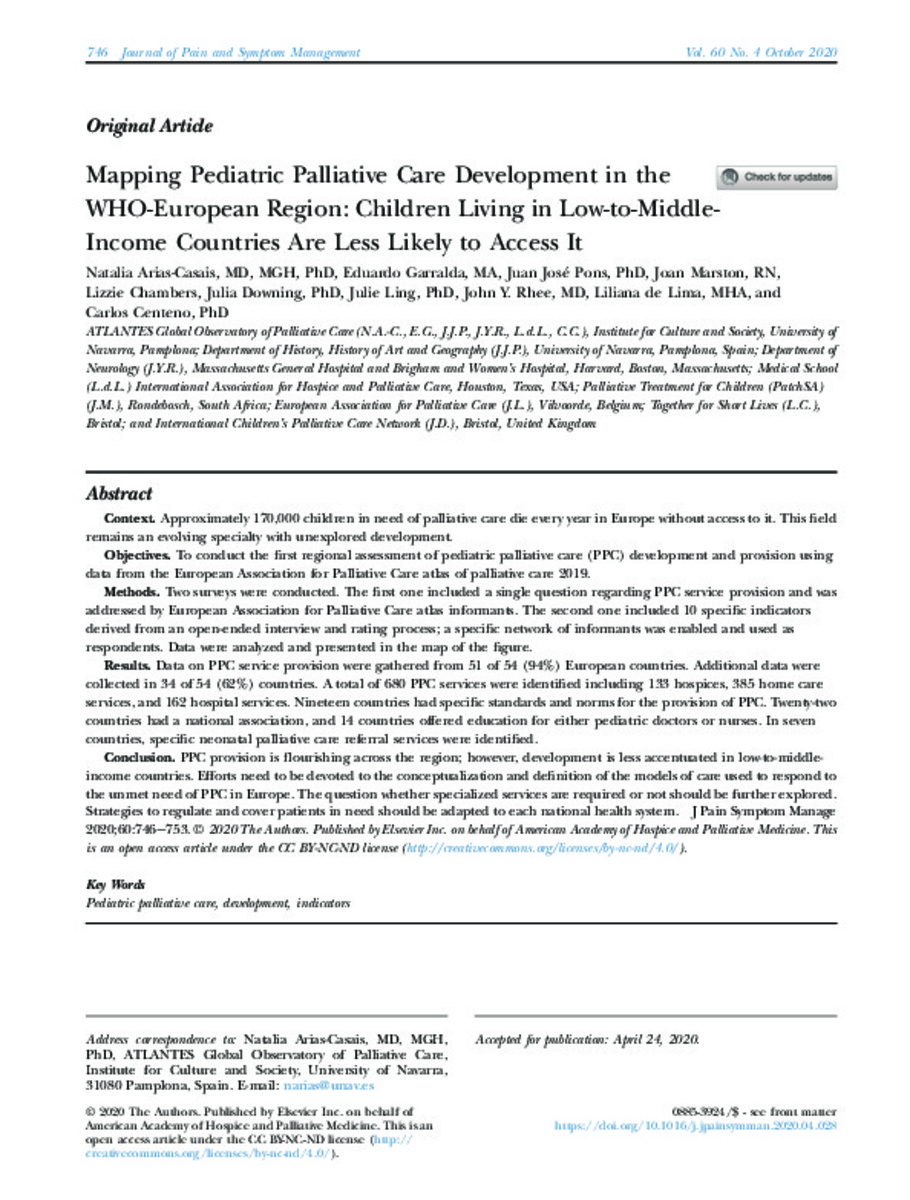Registro completo de metadatos
| Campo DC | Valor | Lengua/Idioma |
|---|---|---|
| dc.creator | Arias-Casais, N. (Natalia) | - |
| dc.creator | Garralda, E. (Eduardo) | - |
| dc.creator | Pons-Izquierdo, J.J. (Juan José) | - |
| dc.creator | Marston, J. (Joan) | - |
| dc.creator | Chambers, L. (Lizzie) | - |
| dc.creator | Downing, J. (Julia) | - |
| dc.creator | Ling, J. (Julie) | - |
| dc.creator | Rhee, J.Y. (John Y.) | - |
| dc.creator | Lima, L. (Liliana) de | - |
| dc.creator | Centeno, C. (Carlos) | - |
| dc.date.accessioned | 2020-09-30T10:13:36Z | - |
| dc.date.available | 2020-09-30T10:13:36Z | - |
| dc.date.issued | 2020 | - |
| dc.identifier.citation | Arias-Casais N, Garralda E, Pons JJ, Marston J, Chambers L, Downing J, et al. Mapping pediatric palliative care development in the WHO-European Region: children living in low-middle income countries are less likely to access it. J Pain Symptom Manage. 2020 Oct 1;60(4):746–753. | es_ES |
| dc.identifier.issn | 0885-3924 | - |
| dc.identifier.uri | https://hdl.handle.net/10171/59512 | - |
| dc.description.abstract | Context: Approximately 170,000 children in need of palliative care die every year in Europe without access to it. This field remains an evolving specialty with unexplored development. Objectives: To conduct the first regional assessment of pediatric palliative care (PPC) development and provision using data from the European Association for Palliative Care atlas of palliative care 2019. Methods: Two surveys were conducted. The first one included a single question regarding PPC service provision and was addressed by European Association for Palliative Care atlas informants. The second one included 10 specific indicators derived from an open-ended interview and rating process; a specific network of informants was enabled and used as respondents. Data were analyzed and presented in the map of the figure. Results: Data on PPC service provision were gathered from 51 of 54 (94%) European countries. Additional data were collected in 34 of 54 (62%) countries. A total of 680 PPC services were identified including 133 hospices, 385 home care services, and 162 hospital services. Nineteen countries had specific standards and norms for the provision of PPC. Twenty-two countries had a national association, and 14 countries offered education for either pediatric doctors or nurses. In seven countries, specific neonatal palliative care referral services were identified. Conclusion: PPC provision is flourishing across the region; however, development is less accentuated in low-to-middle-income countries. Efforts need to be devoted to the conceptualization and definition of the models of care used to respond to the unmet need of PPC in Europe. The question whether specialized services are required or not should be further explored. Strategies to regulate and cover patients in need should be adapted to each national health system. | es_ES |
| dc.language.iso | eng | es_ES |
| dc.publisher | Elsevier | es_ES |
| dc.rights | info:eu-repo/semantics/openAccess | es_ES |
| dc.subject | Pediatric palliative care | es_ES |
| dc.subject | Development | es_ES |
| dc.subject | Indicators | es_ES |
| dc.title | Mapping pediatric palliative care development in the WHO-European Region: children living in low-middle income countries are less likely to access it | es_ES |
| dc.type | info:eu-repo/semantics/article | es_ES |
| dc.description.note | This is an open access article under the CC BY-NC-ND license (http://creativecommons.org/licenses/by-nc-nd/4.0/). | es_ES |
| dc.identifier.doi | 10.1016/j.jpainsymman.2020.04.028 | - |
Ficheros en este ítem:
Estadísticas e impacto
Los ítems de Dadun están protegidos por copyright, con todos los derechos reservados, a menos que se indique lo contrario.






